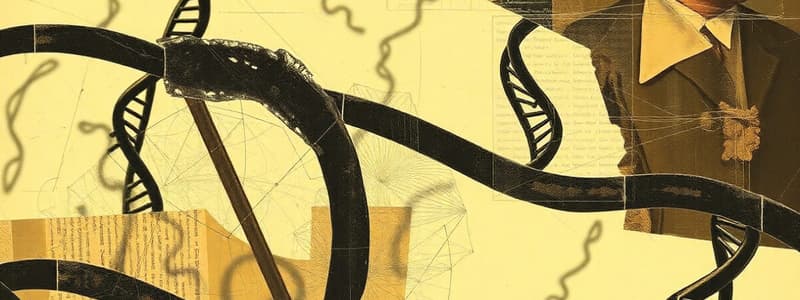Podcast
Questions and Answers
What is the primary role of DNA in living organisms?
What is the primary role of DNA in living organisms?
- To encode genetic information (correct)
- To produce energy for the cell
- To facilitate chemical reactions
- To transport nutrients
Which process requires both paternal and maternal genetic contributions?
Which process requires both paternal and maternal genetic contributions?
- Meiosis
- Mitosis
- Asexual reproduction
- Sexual reproduction (correct)
What major initiative provided a comprehensive map of human chromosomes?
What major initiative provided a comprehensive map of human chromosomes?
- The Genetic Engineering Program
- The Chromosome Mapping Initiative
- The Human Genome Project (correct)
- The Human Cell Project
What type of inheritance involves genes located on sex chromosomes?
What type of inheritance involves genes located on sex chromosomes?
Which type of cell division is responsible for producing gametes?
Which type of cell division is responsible for producing gametes?
What is a mutation?
What is a mutation?
How does ageing affect genetics?
How does ageing affect genetics?
In the context of gene function, what does transcription refer to?
In the context of gene function, what does transcription refer to?
What is the significance of genetic counseling?
What is the significance of genetic counseling?
Which genetic abnormality is commonly associated with cancer?
Which genetic abnormality is commonly associated with cancer?
Flashcards are hidden until you start studying
Study Notes
Chromosomes, Genes and DNA
- Chromosomes are thread-like structures found in the nucleus of every cell. They carry genetic information in the form of genes.
- Genes are segments of DNA that code for specific traits.
- DNA, or deoxyribonucleic acid, is a complex molecule composed of two strands twisted into a double helix. It contains the genetic instructions for an organism to develop and function.
- Mutations are changes in the DNA sequence that can lead to altered traits.
Protein Synthesis
- Messenger ribonucleic acid (mRNA) carries genetic information from DNA in the nucleus to the ribosomes, where protein synthesis occurs.
Cell Division
- Mitosis is a type of cell division that results in two daughter cells identical to the parent cell. It is essential for growth and repair.
- Meiosis is a specialized type of cell division that produces gametes (sperm and egg cells). It involves two divisions, resulting in four daughter cells with half the number of chromosomes as the parent cell. This is crucial for sexual reproduction.
The Genetic Basis of Inheritance
- Autosomal inheritance refers to the inheritance of traits that are determined by genes located on non-sex chromosomes (autosomes).
- Sex-linked inheritance describes the inheritance of traits that are determined by genes located on sex chromosomes (X and Y). These genes can be expressed differently in males and females.
Ageing and Genetics
- The ageing process is influenced by genetics, and can affect chromosome structure, cell division, and heredity.
Genetic Basis of Disease
- Cancer is often caused by mutations in genes that control cell growth and division.
- Inherited diseases are caused by mutations in genes that are passed down from parents to their offspring.
Studying That Suits You
Use AI to generate personalized quizzes and flashcards to suit your learning preferences.




